
Inverness is a city in the Scottish Highlands. It is the administrative centre for The Highland Council and is regarded as the capital of the Highlands. Historically it served as the county town of the county of Inverness-shire. Inverness lies near two important battle sites: the 11th-century battle of Blàr nam Fèinne against Norway which took place on the Aird, and the 18th century Battle of Culloden which took place on Culloden Moor. It is the northernmost city in the United Kingdom and lies within the Great Glen at its northeastern extremity where the River Ness enters the Beauly Firth. At the latest, a settlement was established by the 6th century with the first royal charter being granted by Dabíd mac Maíl Choluim in the 12th century. Inverness and Inverness-shire are closely linked to various influential clans, including Clan Mackintosh, Clan Fraser and Clan MacKenzie.

ROTOR was an elaborate air defence radar system built by the British Government in the early 1950s to counter possible attack by Soviet bombers. To get it operational as quickly as possible, it was initially made up primarily of WWII-era systems, notably the original Chain Home radars for the early warning role, and the AMES Type 7 for plotting and interception control. Data from these stations was sent to a network of control stations, mostly built underground, using an extensive telephone and telex network.

Royal Air Force Boulmer or RAF Boulmer is a Royal Air Force station near Alnwick in Northumberland, England, and is home to Aerospace Surveillance and Control System (ASACS) Force Command, Control and Reporting Centre (CRC) Boulmer.
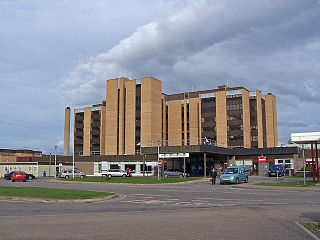
Raigmore Hospital is a health facility located in Inverness, Scotland. It serves patients from the local area as well as providing specialist services to patients from across the Highland area. It is a teaching hospital, educating a range of healthcare professionals in association with the Universities of Aberdeen and Stirling. It is managed by NHS Highland.

RAF Rudloe Manor, formerly RAF Box, was a Royal Air Force station located north-east of Bath, England, between the settlements of Box and Corsham, in Wiltshire. It was one of several military installations situated in the area and covered three dispersed sites. The sites are now used by Defence Digital.
Auldearn is a village situated east of the River Nairn, just outside Nairn in the Highland council area of Scotland. It takes its name from William the Lyon's castle of Eren, built there in the 12th century.
NHS Highland is one of the fourteen regions of NHS Scotland. Geographically, it is the largest Health Board, covering an area of 32,500 km2 (12,500 sq mi) from Kintyre in the south-west to Caithness in the north-east, serving a population of 320,000 people. In 2016–17 it had an operating budget of £780 million. It provides prehospital care, primary and secondary care services.
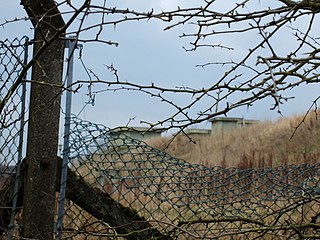
Royal Air Force Barton Hall or more simply RAF Barton Hall is a former Royal Air Force station situated between the villages of Barton and Broughton, near Preston, Lancashire, England.

RAF Ventnor is a former Royal Air Force radar station located 0.7 miles (1.1 km) north east of Ventnor on the Isle of Wight, England. It was initially constructed in 1937 as part of a World War II coastal defence programme codenamed Chain Home. The site played an important role during the Second World War, providing early warnings of incoming bomber attacks carried out by the Luftwaffe.

The Mackinnon Memorial Hospital, also known as Broadford Hospital, is a community hospital, located in the village of Broadford on the Isle of Skye. It is managed by NHS Highland.
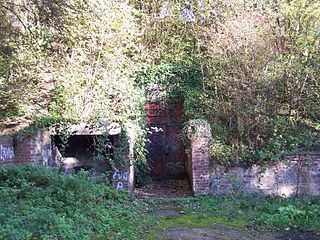
RAF Watnall was the operational headquarters of No. 12 Group, RAF Fighter Command at Wattnal in Nottinghamshire.

Remote Radar Head Trimingham or RRH Trimingham is a TPS-77 radar station situated on the coast in the English county of Norfolk. The site is located on the coast road between Cromer and Mundesley, 1 kilometre east of the village of Trimingham. The radar station is a satellite station of RAF Neatishead. This radar station is controlled and maintained by a section of Radar Technicians and Operators and supported by a team of Ground Engineers. Trimingham provides extensive coverage of the East coast of the United Kingdom and helps contribute to the recognised air picture and defence of the United Kingdom. The type 93 became operational on the site in April 1997.
RAF Sopley was a World War II station, codenamed Starlight, near the village of Sopley in Hampshire. The Radar Station was opened in December 1940. In 1959 it became an air traffic control radar station, and finally closed on 27 September 1974. Nearby Sopley Camp was built in the early 1950s as a domestic site for the radar station and is probably best known as the initial home of the Vietnamese Boat People, in 1979. The camp was sold in 1993 to a local partnership under the name Merryfield Park. Most of the old barracks site had been redeveloped as housing, but the 2-storey building at the Sopley end has been converted into a museum/education centre by Friends Of New Forest Airfields (FONFA). The museum opened in May 2016.

Royal Air Force Holmpton or more simply RAF Holmpton is a former Royal Air Force Cold War era nuclear bunker that was built in the 1950s as an early warning radar station as part of the ROTOR Radar Defence Programme. Located just south of the village of Holmpton, in the East Riding of Yorkshire, England, RAF Holmpton remained a part of the Defence Estate right up to 8 December 2014 when it was sold into private ownership after 62 years of military service.

RAF Blakelaw was a Royal Air Force station which acted as headquarters for No.13 Group during the Second World War and which was located in Blakelaw, Northumberland.

The Battle of Britain Bunker is an underground operations room at RAF Uxbridge, formerly used by No. 11 Group Fighter Command during the Second World War. Fighter aircraft operations were controlled from there throughout the War but most notably during the Battle of Britain and on D-Day. Today it is run by Hillingdon Council as a heritage attraction with attached museum. A new visitor centre above ground opened in March 2018.
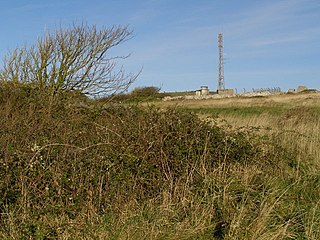
RAF Portland is a former Royal Air Force and ROTOR radar station on the Isle of Portland, Dorset, England. Located close to the Verne Citadel and East Cliff, the station was established in the 1950s as part of a nationwide air defence radar system built by the British Government during the Cold War. The station became a scheduled monument in 2004 and is now the site of the community farm, Fancy's Family Farm.
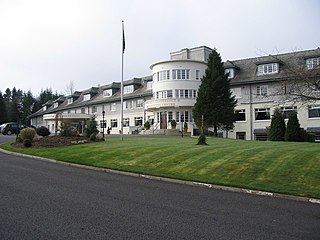
The Drumossie Hotel is an art deco resort and conference centre two kilometers south east of Inverness.
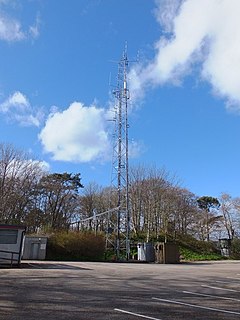
Raigmore House was a country house in Raigmore, Inverness.

Royal Air Force Shipton was a First World War era airfield located north of the village of Shipton-by-Beningbrough, in North Yorkshire, England. During the First World War, it was used by No. 76 Squadron RAF whose remit was to provide Home Defence (HD).
















